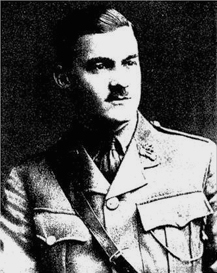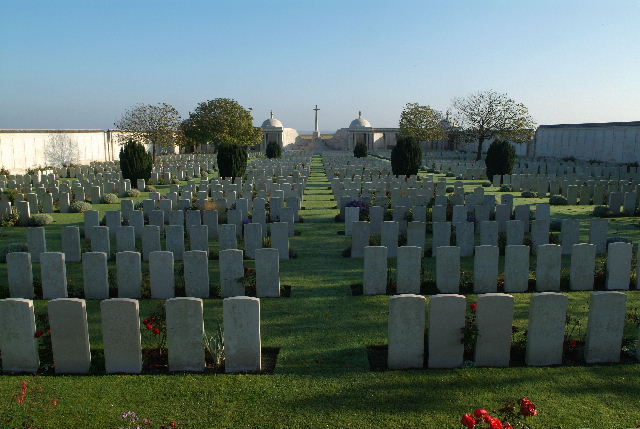Name
Basil Perrin Hicks
Conflict
First World War
Date of Death / Age
25/09/1915
22
Rank, Service Number & Service Details
Lieutenant
Princess Charlotte of Wales’ (Royal Berkshire) Regiment
8th Bn.
Awards: Service Medals/Honour Awards
1914 /15 Star, British War and Victory medals
Cemetery/Memorial: Name/Reference/Country
DUD CORNER CEMETERY, LOOS
VI. B. 19.
France
Headstone Inscription
Not Researched
UK & Other Memorials
Memorial window in St Peter’s Church Memorial, Bushey Heath
Not on the Bushey memorials
Pre War
Basil Perrin Hicks was born on the 22nd October 1892 in Sheffield, the younger son of William Mitchinson Hicks(*1), who was the founding Vice-Chancellor and Professor of Physics at Sheffield University in the early 1900s, and Ellen Hicks.
Basil Perrin Hicks was educated at Rugby School and was a member of the Shoot VIII team when they won the Ashburton Shield and Bisley in 1919 and 1910, He studied in Hanover and Bonn for nine months before entering Trinity College, Cambridge from where he graduated in modern languages in 1914.
Wartime Service
Additional Information
Text adapted from article on St Peter’s Church website and added to. Additional Information’ provided with kind permission of Bushey First World War Commemoration Project – Please visit www.busheyworldwarone.org.uk.
Ida Perrin, the aunt of Basil Perrin Hicks, was an artist and sculptress of some merit and in about 1905, in addition to retaining a Kensington property, she and her husband, Henry, purchased ‘The Cottage’ on Bushey Heath, which is now the site of Hartsbourne Park flats. After taking up residence in Bushey Heath in 1905, the Perrins became committed members of St Peter's and when the Church rebuild project was started in 1911, Henry served on the Building Committee and donated £1100 (equivalent to £52,000 today) towards the total cost of £10,500. The enlarged nave incorporated a new West Window, which was initially in plain glass and when Basil Hicks was killed in 1915, Holiday was commissioned by the Perrins to design a new window in stained glass for the west end of the church in memory of their nephew and which he named The Holy Spirit Window. It was made by Lowndes and Drury at the Glasshouse, Fulham. The five light masterpiece depicts Love, Wisdom, Power, Joy, Truth and Faith, and also incorporates the text "Not by might, nor by power, but by my Spirit, saith the Lord of Hosts" It was dedicated on Sunday the 14th April 1918. Now that it has been cleaned and the remnants of the war-time protective film removed, the colours stand out as a glorious testimony to the brilliance of a master-craftsman.
Maurice Nasmith Perrin, the son of Henry and Ida, who also served in France from August 1914 – 1919, was killed in a flying accident on 28 April 1919, aged 32, and is remembered with honour at Weybridge Cemetery.
On the 10th of November 2002, some 87 years after his death, a new generation paid tribute to the valour and ultimate sacrifice of Lieutenant Hicks in a moving service of remembrance at St Peter's attended by a congregation of over 240 children and adults. During the service, the restored West Window was re-dedicated to Lieutenant Hicks and every Bushey Heath serviceman killed in the two wars was remembered by name, with prayerful thanks by the children for their sacrifice. The collection, which raised £500, went to the Thiepval visitors centre in the Somme, which is being built by public subscription. The Thiepval monument, commemorating 72,000 British soldiers with no known graves, was designed by Sir Edward Lutyens and is the largest Great War memorial in the world.
Basil Hicks is also commemorated – and pictured – in the Great West Window of St Peter’s Church, Bushey Heath, the Outer London suburb which was home to his mother’s family,
As a matter of interest Basil's torch was acquired by Edward Dempsey in 2024.
*1 The Hicks Building at the University is named after him and he and his wife inaugurated and endowed the Basil Perrin Hicks Memorial Lecture as part of the commemoration of his son and lectures are delivered at the University on an occasional basis by such luminaries as Jan Smuts, Lord Alexander, Viscount Slim, A J P Taylor, Roy Jenkins and Lord Owen. Professor and Mrs Hicks originally envisaged that each Lecture should “deal with some aspect of the Great War, either its origins, its conduct or its social and international consequences....”, though in practice a wide range of topics has been covered by the historians, politicians and military men who have given the Lectures since their time. This 2012 Lecture indeed addresses a direct consequence of the War, which by the unprecedented scale of the killing led to the creation of what is now the Commonwealth War Graves Commission to honour the Fallen and to care for their remains.
Acknowledgments
Dianne Payne - www.busheyworldwarone.org.uk, Jonty Wild, www.sheffield.ac.uk, Edward Dempsey



